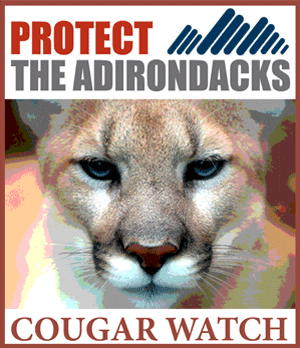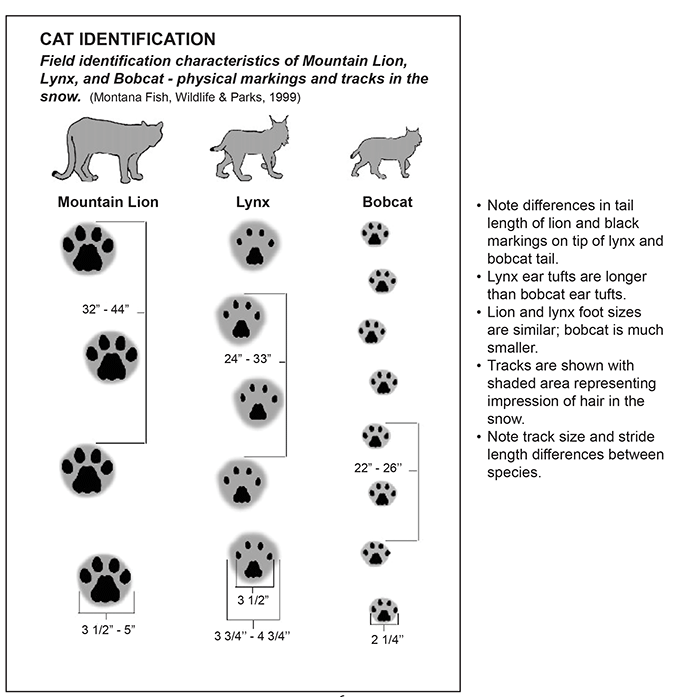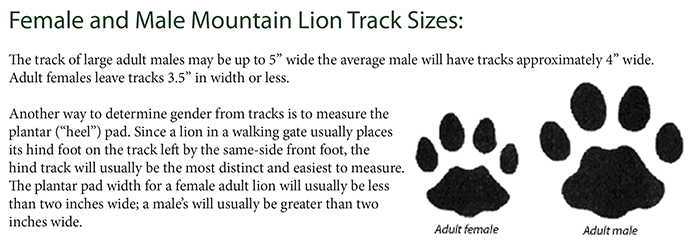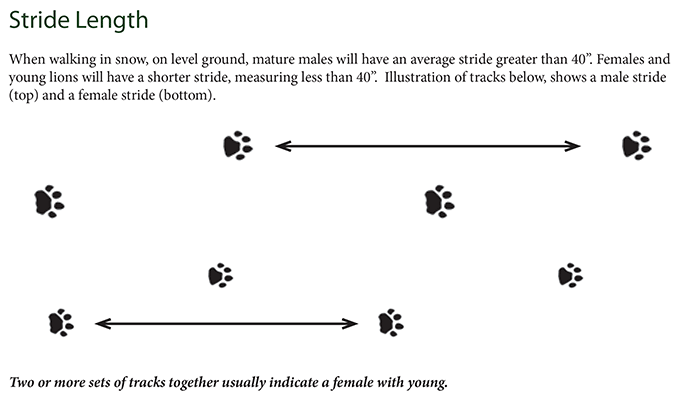Have You Seen a Cougar?
Cougar Watch is a project to record public sightings of cougars (Puma concolor) in and around the Adirondack Park. There are regular reports of cougar sightings throughout the Adirondacks, but there has not been a publicly available repository to record these sightings. Cougar Watch will organize and map these reports.
 The purpose of the Cougar Watch project is two-fold. First, there continue to be regular reports of cougars across the Adirondacks. Jerry Jenkin’s Adirondack Atlas features a map of cougar sightings on page 51. PROTECT will manage a database about all reports made available to us. We will investigate sightings that include information, such as pictures, pictures of tracks, scat samples, etc. Second, if there is a cluster of reports in a specific geographic area, PROTECT will work with cougar experts to try and assess the presence of cougars.
The purpose of the Cougar Watch project is two-fold. First, there continue to be regular reports of cougars across the Adirondacks. Jerry Jenkin’s Adirondack Atlas features a map of cougar sightings on page 51. PROTECT will manage a database about all reports made available to us. We will investigate sightings that include information, such as pictures, pictures of tracks, scat samples, etc. Second, if there is a cluster of reports in a specific geographic area, PROTECT will work with cougar experts to try and assess the presence of cougars.
How to Make a Report
Reports of cougar sightings can be submitted by using this form.
We ask that people have as much information as possible when making a report, including the date, time and location as well as any other information such as paw prints, print measurements, hair or scat samples, if available. Make sure to include all your contact information and tell us whether we can post your name/town as part of your report.
Cougar Watch will provide regular reports of sightings from around the Adirondacks in the years ahead.
How to Identify a Cougar
Bobcats are often mistakenly identified as cougars. The big difference is that cougars have long tails. Paw prints are similar to bobcats and lynx, yet the cougar prints are much bigger. Montana Fish, Wildlife and Parks put out a good publication about how to make a positive identification of a cougar. The Cougar Fund also has good information on cougar identification.

Cougar ID tips from the Montana Fish, Wildlife and Parks. Note the long tail in the diagram above and the size of the cougar paw prints.
Here’s more information about the tracks of a cougar.
A Long History of Cougar Sightings in the Adirondacks
Cougar Watch project follows the work by a PROTECT Board member Peter O’Shea, who for many years recorded sightings of mountain lions in the Adirondacks. O’Shea is a well known naturalist and author. He was profiled in The New York Times in 2004 and in the Washington Post in 2005 about his stalwart work to record cougar sightings throughout the Adirondacks. Throughout the 1990s and early 2000s, O’Shea recorded hundreds of sightings of cougars (also called mountain lions or pumas) from hundreds of people and several times he even tracked cougars in the Adirondacks.
While there have been a number of reports over the years, they are believed to be transients or released captive animals. There is no evidence of a breeding population in the Adirondacks. Without evidence of a sustained local population, debate about the Park’s viability to support a cougar population has been ongoing. PROTECT profiled to work of Dr. John Laundre of SUNY Oswego who published an analysis about the viability of the Adirondacks to support cougars. Laundre published a book about the repopulating of cougars in the Midwest and makes the case they could return to the east. Here’s an excellent overview on the status of cougars in the eastern U.S.
Status of Cougars in the U.S.
The U.S. Fish and Wildlife Service has declared cougars officially extinct in the eastern U.S. As such, any cougar in the east does not have Endangered Species Act protections. If cougars were to recolonize parts of the east or the Adirondacks and a breeding population was confirmed, the U.S. Fish and Wildlife Service would have the evaluate protections at that time. There are no plans for any cougar restorations in the Adirondacks or anywhere else in the eastern U.S. at this time, though restoration remains an objective of organizations such as the Cougar Rewilding Foundation.
Here’s information from the NYS DEC about cougars in New York.
Cougars number in the tens of thousands west of the Mississippi River and occupy almost all large mountainous areas in western states. There are an estimated 15,000 cougars in California alone. In recent years, cougars have naturally recolonized several parts of the west including the Black Hills of South Dakota, the Badlands of North Dakota, and the Pine Ridge area of western Nebraska. South Dakota has embarked upon a new hunting season for cougars this year.
A cougar population of around 150 has survived in Florida. It was successfully augmented recently with the introduction of several males to help widen the gene pool. This population is a remnant population from a time when cougars thrived coast to coast. The Florida population is considered far beyond the reach of even the most freewheeling and well traveled young male cougars to reach on their own. In 2007, one cougar was documented as having traveled from South Dakota to Connecticut, where it was hit by a car. This cougar passed through the Adirondacks.
Here’s information from the Department of Environmental Conservation. Here’s a public radio report on cougars in the Adirondacks.
The new issue of Northeastern Naturalist contains an article (abstract here) from a long-term study “to detect the presence of Puma concolor (Cougar) in eastern Canada.” The research team found “19 positive identifications of cougars in Quebec and New Brunswick.” DNA investigations found that “some specimens were from South America, whereas others had a North American origin.” DNA of South American origin is generally dismissed as escaped pets. There have been reports of up to 1,000 cougars held in captivity east of the Mississippi River, some at licensed facilities, others as part of an illegal exotic animals trade.
A 2010 book The Emerging Cougar Chronicle provides information on the science behind the cougar’s rebound in many parts of the U.S. One chapter argues that the North American cougar is basically one animal from a genetics standpoint, which historically roamed from the east coast to the west coast.


